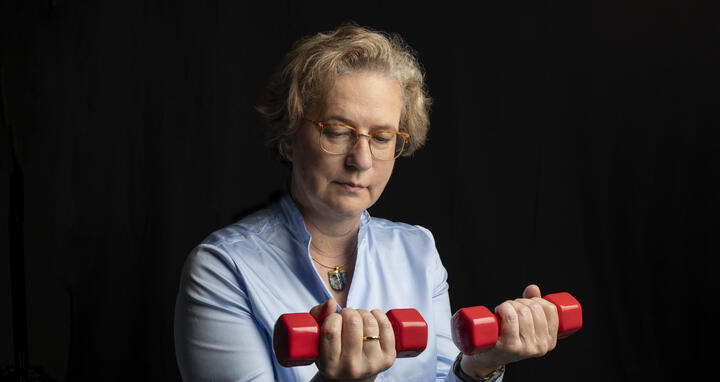A pioneer in muscle repair
There is one patient that neurologist Simone Spuler will never forget. She arrived at the consultation a healthy woman in her mid-40s, full of life and with two children. She said she had always been fit but was gradually losing strength – at one point, she was even struggling to climb stairs. “Her doctors had told her it was normal for young mothers to be less physically able,” recalls Spuler. “We took a tissue sample, sequenced the DNA, and found that she had laminopathy – which is a serious genetic muscle disorder.”
The professor is sitting in her apartment in Charlottenburg, on Berlin’s west side, looking into the camera through gold-rimmed glasses; in the background there is a wooden chest in front of a Gründerzeit door, above which hangs a black-and-white picture of three musicians playing together. This is her day working from home, and she has conversations lined up with grad students, patients, industry partners and colleagues. Science, she says, is like making music together: the collaboration is often difficult, but the end result is far better than a solo.
We have a great responsibility not to give patients false hope, but still to take good care of them and keep them informed about progress.
Simone Spuler is a genetic muscle disease expert at the Experimental and Clinical Research Center (ECRC), a joint institution of Charité – Universitätsmedizin Berlin and the Max Delbrück Center. At the university outpatient clinic on Campus Berlin-Buch, she cares for around 2,000 patients suffering from muscular dystrophy. Her ambitious goal is to tie together basic research and clinical practice to cure some of the most serious genetic muscle diseases.
But today, the outlook for her patients remains bleak, as muscle mass loss is currently irreversible. Over the course of her consultations, Spuler has to watch her patients gradually lose strength and mobility. It’s a demoralizing process. “We have a great responsibility not to give patients false hope, but still to take good care of them and keep them informed about progress,” says Spuler. “We try to make it very clear to them how limited our options are right now.” Spuler was unable to help the mother of two; she died of heart failure at the age of 58.
Muscle is replaced by connective tissue and fat cells
Muscles really are a mechanical marvel. From the root of a strand of hair to the little toe, they control the movement of the body by contracting and relaxing. Our muscles naturally degenerate with age, but certain gene mutations weaken the stability of muscle fibers far too early and cause them to tear. “The body’s own muscle stem cells can repair such damage, but eventually this pool of stem cells is exhausted,” explains Spuler. “At this point, connective tissue and fat cells migrate in and remodel the muscle.”
Of the approximately 400 known genetic muscle diseases, 40 are so severe that they result in the very rapid loss of muscle mass. Spuler focuses on the subgroup of diseases known as limb-girdle muscular dystrophies (LGMDs), which cause weakness and wasting of the body’s muscles, starting in the shoulders and pelvis. She and her team are researching four diseases in this group, including laminopathy.
The beauty of muscle fibers
Spuler first began working with muscles in 1982. As a third-semester medical student, she was finding the teaching too heavily focused on theory and lectures. “I really wanted to do some hands-on research,” recalls Spuler. “Then, all of a sudden, I was invited to join a Max Planck group to help isolate a receptor in a rat muscle.” What began as an interest developed into a passion. “Muscles really are beautiful,” enthuses Spuler. “Muscle fiber preparations have such a uniform structure and, in some cases, produce wonderfully nuanced staining patterns.”
She chose to specialize in muscular dystrophy as a postdoc at the Max Planck Institute of Biochemistry in Martinsried in the 1990s, which was when the first genes that cause these diseases had just been discovered. “It was really exciting to witness this and to realize how many genes are responsible for different diseases,” Spuler remembers. She learned how to sort through the molecular mechanisms at the Mayo Clinic in Rochester, Minnesota.
Back in Germany, her attentions were initially focused on her two children, who were both still very young. But she soon threw herself back into analyzing human muscle stem cells and, in addition to her research, established a special outpatient clinic for muscle disorders at Charité. In 2015 she decided to combine her knowledge with findings from the fields of stem cell biology and genome surgery, with the hope of developing a therapy for genetic muscle diseases.
Simone Spuler
Repairing genes with scissors and tweezers
Unlike with kidney, lung or heart tissue, it is not possible to replace diseased muscle tissue by transplantation. Any cure would require repairing the mutated genes that weaken it. Luckily, CRISPR-Cas9 can do just that. The Cas9 enzyme works much like scissors, snipping the DNA strand at the desired location and then inserting new genetic material into the cell. In the laboratory, Spuler’s team has already succeeded in injecting “repaired” muscle stem cells into diseased mice and thus restoring their ability to grow muscles again. The stem cells fuse with the diseased cells in the muscle tissue and help form new muscle fibers.
For some mutations that may underlie laminopathy and LGMD2D, there is an even more precise method – known as “base editing” – that lends itself to therapeutic intervention. This advancement of CRISPR-Cas9 technology is less error-prone because the altered Cas9 works more like tweezers than scissors: instead of cutting
the DNA double strand, its swaps out a single base. The researchers have already used these “tweezers” in muscle stem cells from a 10-year-old with LGMD2D and then injected the repaired cells into mice. In most instances, these cells also gave rise to new muscle fibers.
“A huge step forward in terms of quality of life”
Spuler plans to inject repaired muscle stem cells into the muscle of patients, where they can form new fibers as well as muscle stem cells. For certain patients, this step is right around the corner. Yet the amount of stem cells that scientists can produce in the laboratory is too small to supply all the muscles in the body. The current limit is 80 to 100 million cells. That’s enough to repair individual muscle parts, such as finger flexors or the orbicularis oculi muscles that enable patients to close their eyelids again. “That would be a huge step in terms of quality of life,” says Spuler – who’s already thinking about what to do next. Her vision is to insert molecular tweezers directly into the body. “A carrier molecule will transport them into muscle tissue, where they will work for a few hours before breaking down,” says Spuler. Such an approach could repair all the muscle cells in the body.
Spuler may also be able to help the children of the patient who died of laminopathy at age 58. Her team has built up an archive – known as the Myopax biobank – of muscle stem cells from patients with the disease. The processed cells will be stored here until a therapy is approved. Patients would otherwise be in a race against time, because the stem cells are also destroyed during the progression of muscular dystrophy – and a cure that relies on their help is becoming increasingly unlikely. In the biobank, however, their regenerative potential is preserved and can be tapped into once the disease has progressed into more advanced stages.
“We don’t want to change God’s work”
Optimism and compassion are what drive Spuler – and she is passing these qualities on to the next generation of scientists. “It’s a very laborious process and real painstaking work to correct exactly the right genes,” she says, “but I believe it’s absolutely worth it.” And this conviction remains unshakeable, even when the day’s work drags into the night and her thoughts keep spinning on and on. She finds relaxation at the opera, especially productions like Die Meistersinger, Giulio Cesare and Castorf’s Ring. Or she unwinds over an evening meal with her family in their Charlottenburg flat, where musings about base pairs dissolve into cumin and harissa.
In quieter moments, she is beset by doubts. So much so that she has attended church council meetings so as to face critical questions from people of faith. “I explain to them that with genome editing we are not changing God’s work, but trying to cure a disease in a very targeted way,” she says. “In principle, it’s like a surgeon removing a tumor.” She is devoting all her present efforts to developing a safe gene therapy that can be used to repair muscle cells. So that one day she will be able to sit across from her patients in the university outpatient clinic and say “We can fix that.”
Text: Mirco Lomoth
Further Information







